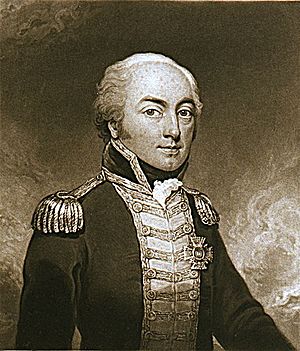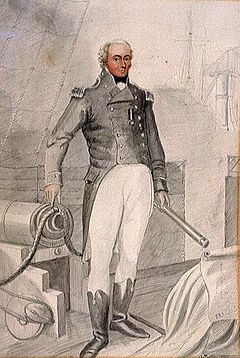George Johnstone Hope facts for kids
Quick facts for kids
Sir George Johnstone Hope
|
|
|---|---|

Rear-Admiral Sir George Johnstone Hope KCB
|
|
| Born | 6 July 1767 Scotland |
| Died | 2 May 1818 (aged 50) London |
| Allegiance | United Kingdom |
| Service/ |
Royal Navy |
| Years of service | 1781-1818 |
| Rank | Rear-Admiral of the White |
| Commands held | HMS Defence |
| Battles/wars | War of 1812 Napoleonic Wars :Battle of Trafalgar |
| Awards | KCB Commander of the Order of the Sword |
| Other work | Member of Parliament |
Sir George Johnstone Hope (born July 6, 1767 – died May 2, 1818) was a brave British naval officer. He served in the Royal Navy during the French Revolutionary and Napoleonic Wars. He was a close friend of Admiral Nelson and fought with great skill at the famous Battle of Trafalgar. After the battle, he received many awards. Later in his life, he became a Lord of the Admiralty, which was a very important job in the navy.
Contents
George Johnstone Hope was born in Scotland. His father was The Hon. Charles Hope-Weir. George joined the navy when he was just 15 years old in 1782. He spent his early years serving on fast ships called frigates.
He quickly moved up the ranks. On February 29, 1788, he became a lieutenant. Then, on November 22, 1790, he was given command of his own small warship, HMS Racehorse.
Serving in the Wars
When Britain entered the war against France, Hope was commanding HMS Bulldog. He was in the Mediterranean Sea, helping to protect supply ships. These ships were bringing supplies to British forces.
In September 1793, he was promoted to Post Captain. This was a big step up! In August 1794, he took command of a large frigate called HMS Romulus. He fought against French ships near Genoa in 1795.
Joining Nelson's Fleet
Later, Hope commanded HMS Alcmene. He joined Admiral Nelson at Aboukir Bay. This was just after the famous battle of the Nile. Nelson left some ships, including Alcmene, to block the French ships in Alexandria.
Hope impressed Nelson by capturing a French gunboat called Légère. His crew bravely jumped into the water to get important papers the French captain had thrown overboard. Hope then sailed to Naples. He successfully helped the royal family escape during a rebellion. Nelson later helped to stop this uprising.
By 1801, Hope was very experienced in the Mediterranean. He commanded HMS Leda. He helped British forces land in Egypt, which led to a successful invasion.
The Battle of Trafalgar
After a short period of peace, Hope returned to sea. He commanded HMS Defence, a powerful 74-gun ship. When Spain joined the war in 1804, Defence became part of a new squadron.
Joining Nelson's Main Fleet
Hope and Defence stayed with the main British fleet. In September 1805, they joined a squadron near Cádiz. Here, they helped to block the French and Spanish fleets. Admiral Nelson arrived on September 29. He moved his ships out to sea to try and lure the enemy fleet out.
On October 19, the French and Spanish fleet finally sailed out. Defence was one of the ships that sent the signal to Nelson.
Hope's Role in the Battle
On the morning of October 21, 1805, the Battle of Trafalgar began. Hope's ship, Defence, was at the back of Admiral Collingwood's group of ships. This meant Defence could not join the fight right away.
However, after about two and a half hours, Defence was heavily involved. It fought bravely against the French ship Berwick. Then, it battled the Spanish ship San Ildefenso. After hours of fighting, Hope received the surrender of the San Ildefenso.
Surviving the Storm
After the battle, a terrible storm hit. Hope made a very smart decision. He anchored both his ship and the captured Spanish ship. This was against the general confusion and lack of orders. Because of his quick thinking, his captured ship was one of only four prizes to survive the gales.
Even though Defence fought hard, Hope's crew had very few casualties. Only seven sailors died, and twenty-nine were injured. After the storm, Admiral Collingwood put Hope in charge of sinking the remaining captured ships. This was to stop the enemy from getting them back. It was a very difficult job in the rough seas, and Hope was praised for it.
Later Years and Legacy
After Trafalgar, Hope continued to serve on Defence until 1809. He then became Captain of the Fleet under Sir James Saumarez. Hope helped protect British trade in the Baltic Sea. He was Saumarez's chief of staff until August 12, 1811. He was then promoted to Rear-Admiral of the Blue. A year later, he became Rear Admiral of the White.
In 1812, Napoleon invaded Russia. Hope was sent back to the Baltic. His mission was to rescue as much of the Russian fleet as possible. This plan was not fully carried out because Napoleon was defeated.
Hope was rewarded with a position as one of the Lords of the Admiralty. He held this important job for six years. His service ended suddenly when he died on May 2, 1818, while working late. He was also a Member of Parliament for East Grinstead from 1815.
He received many honors, including being made a Knight Commander of the Order of the Bath. He also got a special sword and a gold medal for his bravery at Trafalgar. Sir George Johnstone Hope was buried in Westminster Abbey. A large memorial there remembers his service.
Family Life
George Johnstone Hope married his cousin, Lady Jemima Hope. She passed away in 1808, leaving him with two young children. Their son, Sir James Hope, also became a naval officer. He rose to the high rank of Admiral of the Fleet.
Hope married again in 1814 to Georgina Kinnaird. They had a second daughter together.


